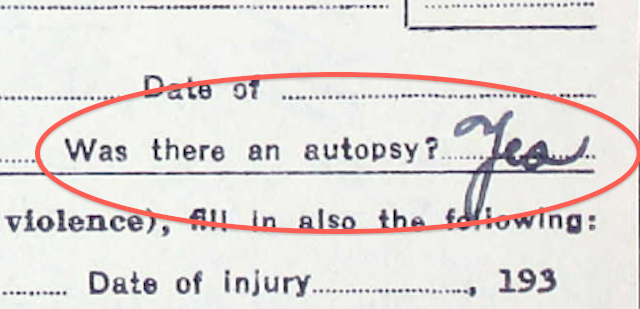
We should remember this for all records but, when you find a death certificate, it's important to take the time to look at everything written. Reading every section could lead you to additional records you should investigate.
If the medical professional's signature indicates "coroner" after it, or it shows that an autopsy was performed, you should check for coroner records. If the death was a homicide, suicide, accidental, or of an unknown cause, there's a good chance that a coroner was called in to investigate and a file exists.
While some coroner files haven't told me anything I hadn't already found in newspaper articles, in the case of others, I learned more about my relatives' lives. For example, the 1938 report for my great-uncle John Stenglein shows that he had been living at 1101 Carson Street on the South Side of Pittsburgh for three years and had been working for the Works Progress Administration for six months. One of the witnesses in the report was his friend, Dan Sheridan, who had known John for "15 to 20 years" and was rooming with him for 3 days before his death (which was ruled as alcoholic gastroenteritis). Since I haven't been able to find John in the 1930 census and the last record I had of him was from a 1925 city directory, these extra details are very welcome.
I've had mixed success with obtaining coroner records. In Southwestern Pennsylvania, access to coroner records varies:
Allegheny County - The University of Pittsburgh Archives maintains a
coroner case file database for Allegheny County. You first email its staff to request a free search for the name of your deceased relative. If they find a match, they will provide you with a file number and a link to the request form that you submit along with $12, which includes copying and mailing charges. They responded to me the day after I sent my email. Very impressive! Files I have received from them have been about 10-12 pages.
Westmoreland County - This county allows you to
search online for records from the early 1900s to 1996 and provides a one-page summary of the death. The website says "[s]ome older records may not be available as they were lost, damaged or destroyed many years ago." I couldn't find any of my relatives in this database, but you can search by name (make sure you use a wildcard, like smith*) or by date. I randomly picked the date of August 10, 1912, and it retrieved four deaths. When I clicked on the first name, James J. Cushing, it showed me that he resided in New York, was 45 years old and married, and the decision by the coroner was "death due to injuries received in attempting to board a moving freight train on P.R.R. at Bradenville. Trespassing. Died in Latrobe Hospital."
Washington County - This county has been a source of frustration for me. I emailed the coroner's office a year ago and received no response. I tried again, and still no response. The third time, I think I practically begged and finally heard back from them. A woman simply stated that they did not have any records going back to the 1930s. Last month, I decided to contact the
Washington County Historical Society to see if they knew if any of the records had been archived. A gentleman told me that I had been misinformed by the woman at the coroner's office and suggested that I email them again. I know you won't be surprised to hear that I'm still waiting for a response.
A quick Google search of coroner records shows that there are other states where you can search these records online, such as the
Missouri Coroner's Inquest Database and
Cook County [Illinois] Coroner's Inquest Record Index. FamilySearch.org also has some online coroner records, so be sure to search around to find out what's available for the locations where your ancestors died.









%2BTimes%2BNewspaper.png)


